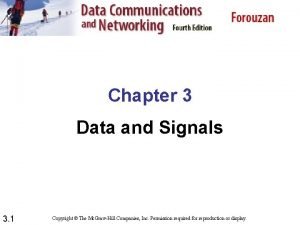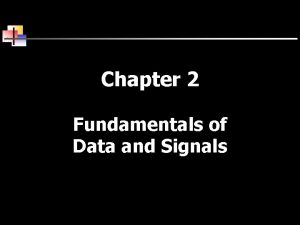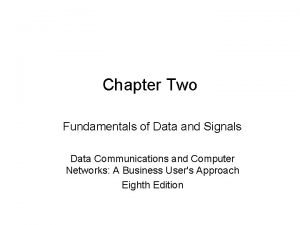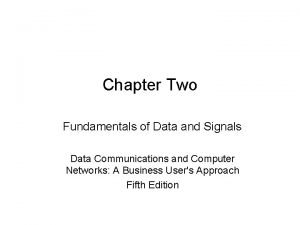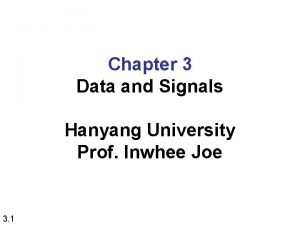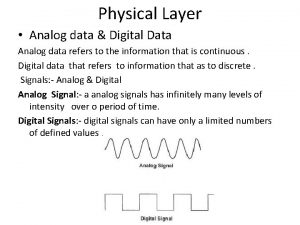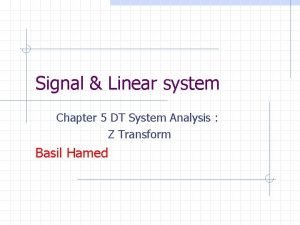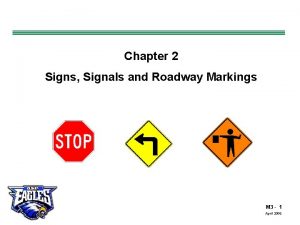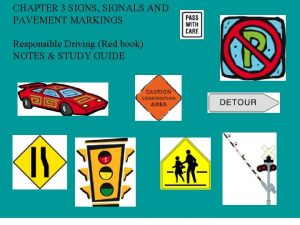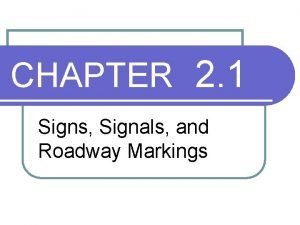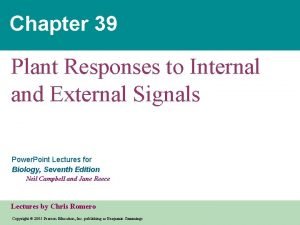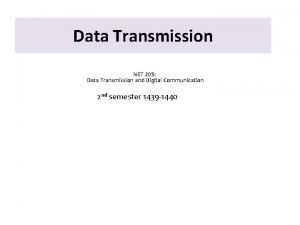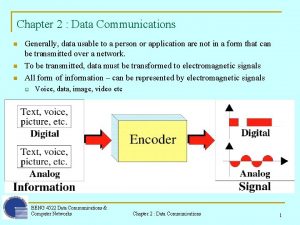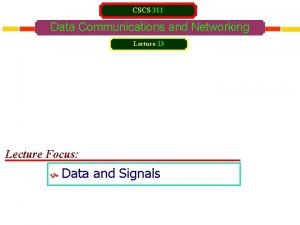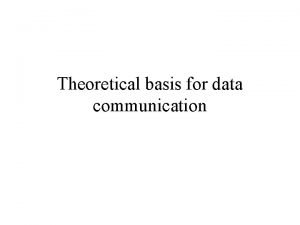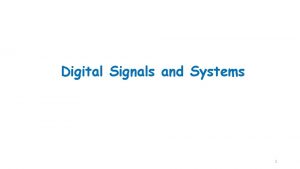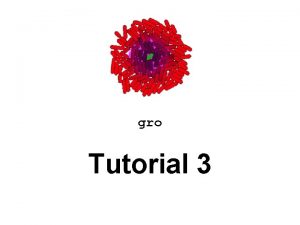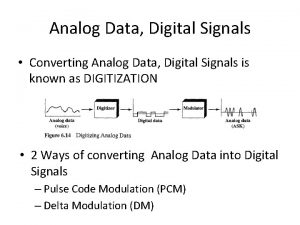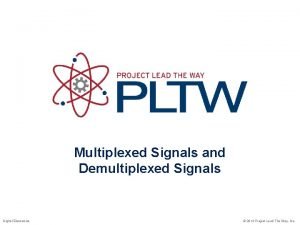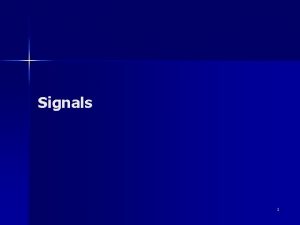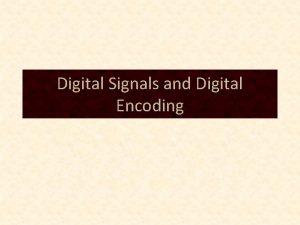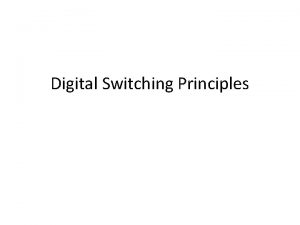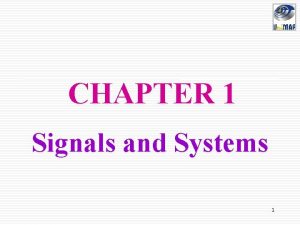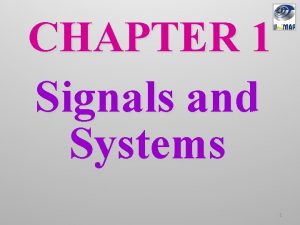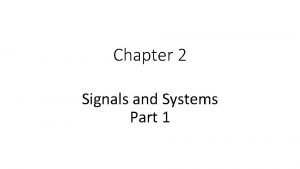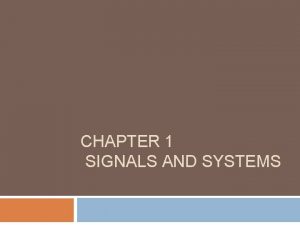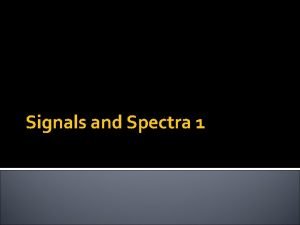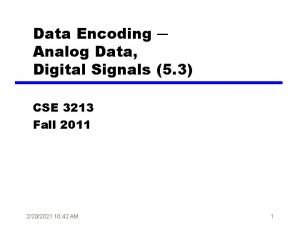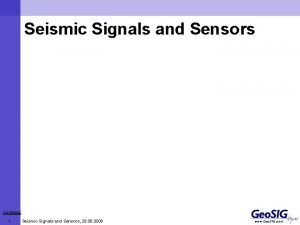Chapter 3 Data and Signals 3 3 DIGITAL


























- Slides: 26

Chapter 3 Data and Signals

3 -3 DIGITAL SIGNALS In addition to being represented by an analog signal, information can also be represented by a digital signal. For example, a 1 can be encoded as a positive voltage and a 0 as zero voltage. A digital signal can have more than two levels. In this case, we can send more than 1 bit for each level. Topics discussed in this section: § Bit Rate § Bit Length § Digital Signal as a Composite Analog Signal § Application Layer

Figure 3. 16 Two digital signals: one with two signal levels and the other with four signal levels

Example 3. 16 A digital signal has eight levels. How many bits are needed per level? We calculate the number of bits from the formula Each signal level is represented by 3 bits.

Example 3. 17 A digital signal has nine levels. How many bits are needed per level? We calculate the number of bits by using the formula. Each signal level is represented by 3. 17 bits. However, this answer is not realistic. The number of bits sent per level needs to be an integer as well as a power of 2. For this example, 4 bits can represent one level.

Example 3. 18 Assume we need to download text documents at the rate of 100 pages per sec. What is the required bit rate of the channel? Solution A page is an average of 24 lines with 80 characters in each line. If we assume that one character requires 8 bits (ascii), the bit rate is

Example 3. 19 A digitized voice channel, as we will see in Chapter 4, is made by digitizing a 4 -k. Hz bandwidth analog voice signal. We need to sample the signal at twice the highest frequency (two samples per hertz). We assume that each sample requires 8 bits. What is the required bit rate? Solution The bit rate can be calculated as

Example 3. 20 What is the bit rate for high-definition TV (HDTV)? Solution HDTV uses digital signals to broadcast high quality video signals. The HDTV screen is normally a ratio of 16 : 9. There are 1920 by 1080 pixels per screen, and the screen is renewed 30 times per second. Twenty-four bits represents one color pixel. The TV stations reduce this rate to 20 to 40 Mbps through compression.

Figure 3. 17 The time and frequency domains of periodic and nonperiodic digital signals

Figure 3. 18 Baseband transmission

Note A digital signal is a composite analog signal with an infinite bandwidth.

Figure 3. 19 Bandwidths of two low-pass channels

Figure 3. 20 Baseband transmission using a dedicated medium

Note Baseband transmission of a digital signal that preserves the shape of the digital signal is possible only if we have a low-pass channel with an infinite or very wide bandwidth.

Example 3. 21 An example of a dedicated channel where the entire bandwidth of the medium is used as one single channel is a LAN. Almost every wired LAN today uses a dedicated channel for two stations communicating with each other. In a bus topology LAN with multipoint connections, only two stations can communicate with each other at each moment in time (timesharing); the other stations need to refrain from sending data. In a star topology LAN, the entire channel between each station and the hub is used for communication between these two entities.

Figure 3. 21 Rough approximation of a digital signal using the first harmonic for worst case

Figure 3. 22 Simulating a digital signal with first three harmonics

Note In baseband transmission, the required bandwidth is In baseband transmission, the required proportional to the bit rate; if we need to send bits faster, we needto more bandwidth is proportional thebandwidth. bit rate; if we need to send bits faster, we need more bandwidth.

Table 3. 2 Bandwidth requirements

Example 3. 22 What is the required bandwidth of a low-pass channel if we need to send 1 Mbps by using baseband transmission? Solution The answer depends on the accuracy desired. a. The minimum bandwidth, is B = bit rate /2, or 500 k. Hz. b. A better solution is to use the first and the third harmonics with B = 3 × 500 k. Hz = 1. 5 MHz. c. Still a better solution is to use the first, third, and fifth harmonics with B = 5 × 500 k. Hz = 2. 5 MHz.

Example 3. 22 We have a low-pass channel with bandwidth 100 k. Hz. What is the maximum bit rate of this channel? Solution The maximum bit rate can be achieved if we use the first harmonic. The bit rate is 2 times the available bandwidth, or 200 kbps.

Figure 3. 23 Bandwidth of a bandpass channel

Note If the available channel is a bandpass channel, we cannot send the digital signal directly to the channel; we need to convert the digital signal to an analog signal before transmission.

Figure 3. 24 Modulation of a digital signal for transmission on a bandpass channel

Example 3. 24 An example of broadband transmission using modulation is the sending of computer data through a telephone subscriber line, the line connecting a resident to the central telephone office. These lines are designed to carry voice with a limited bandwidth. The channel is considered a bandpass channel. We convert the digital signal from the computer to an analog signal, and send the analog signal. We can install two converters to change the digital signal to analog and vice versa at the receiving end. The converter, in this case, is called a modem which we discuss in detail in Chapter 5.

Example 3. 25 A second example is the digital cellular telephone. For better reception, digital cellular phones convert the analog voice signal to a digital signal (see Chapter 16). Although the bandwidth allocated to a company providing digital cellular phone service is very wide, we still cannot send the digital signal without conversion. The reason is that we only have a bandpass channel available between caller and callee. We need to convert the digitized voice to a composite analog signal before sending.
 Digital data digital signals
Digital data digital signals Data encoding and modulation
Data encoding and modulation Animals and human language chapter 2
Animals and human language chapter 2 Arbitrariness in human language and animal language
Arbitrariness in human language and animal language Communicative signals and informative signals
Communicative signals and informative signals Analogue and digital transmission in computer networks
Analogue and digital transmission in computer networks Digital smoke signals
Digital smoke signals Data encoding techniques
Data encoding techniques Data and signals
Data and signals Fundamentals of data and signals
Fundamentals of data and signals Fundamentals of data and signals
Fundamentals of data and signals Data and signals
Data and signals Data and signals
Data and signals Analog data and digital data
Analog data and digital data Signals and systems oppenheim solutions chapter 5
Signals and systems oppenheim solutions chapter 5 Fluorescent optic yellow signs
Fluorescent optic yellow signs Regulatory signs color
Regulatory signs color What are the 6 types of special roadway markings
What are the 6 types of special roadway markings Signs signals and pavement markings
Signs signals and pavement markings Chapter 2 signs signals and roadway markings answer key
Chapter 2 signs signals and roadway markings answer key Chapter 2 signs signals and roadway markings
Chapter 2 signs signals and roadway markings Chapter 39 plant responses to internal and external signals
Chapter 39 plant responses to internal and external signals Composite signals in data communication
Composite signals in data communication Composite signals in data communication
Composite signals in data communication Composite signals in data communication
Composite signals in data communication Composite signals in data communication
Composite signals in data communication Digital market and digital goods
Digital market and digital goods








